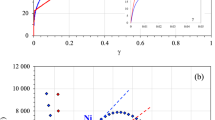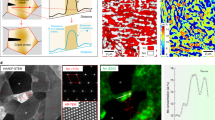Abstract
Hydrogen embrittlement jeopardizes the use of high-strength steels in critical load-bearing applications. However, uncertainty regarding how hydrogen affects dislocation motion, owing to the lack of quantitative experimental evidence, hinders our understanding of hydrogen embrittlement. Here, by studying the well-controlled, cyclic, bow-out motions of individual screw dislocations in α-iron, we find that the critical stress for initiating dislocation motion in a 2 Pa electron-beam-excited H2 atmosphere is 27–43% lower than that in a vacuum environment, proving that hydrogen enhances screw dislocation motion. Moreover, we find that aside from vacuum degassing, cyclic loading and unloading facilitates the de-trapping of hydrogen, allowing the dislocation to regain its hydrogen-free behaviour. These findings at the individual dislocation level can inform hydrogen embrittlement modelling and guide the design of hydrogen-resistant steels.
This is a preview of subscription content, access via your institution
Access options
Access Nature and 54 other Nature Portfolio journals
Get Nature+, our best-value online-access subscription
$29.99 / 30 days
cancel any time
Subscribe to this journal
Receive 12 print issues and online access
$259.00 per year
only $21.58 per issue
Buy this article
- Purchase on Springer Link
- Instant access to full article PDF
Prices may be subject to local taxes which are calculated during checkout




Similar content being viewed by others
Data availability
The data that support the findings of this study are available from the corresponding authors upon reasonable request.
References
Beachem, C. D. A new model for hydrogen-assisted cracking (hydrogen ‘embrittlement’). Metall. Mater. Trans. B 3, 441–455 (1972).
Birnbaum, H. K. & Sofronis, P. Hydrogen-enhanced localized plasticity—a mechanism for hydrogen-related fracture. Mater. Sci. Eng. A 176, 191–202 (1994).
Oriani, R. A. A mechanistic theory of hydrogen embrittlement of steels. Ber. Bunsenges. Phys. Chem. 76, 848–857 (1972).
Sakaki, K. et al. The effect of hydrogen on vacancy generation in iron by plastic deformation. Scr. Mater. 55, 1031–1034 (2006).
Li, S. et al. The interaction of dislocations and hydrogen-vacancy complexes and its importance for deformation-induced proto nano-voids formation in α-Fe. Int. J. Plast. 74, 175–191 (2015).
Kimura, A. & Birnbaum, H. K. Plastic softening by hydrogen plasma charging in pure iron. Scr. Metall. Mater. 21, 53–57 (1987).
Matsui, H., Kimura, H. & Moriya, S. The effect of hydrogen on the mechanical properties of high purity iron I. Softening and hardening of high purity iron by hydrogen charging during tensile deformation. Mater. Sci. Eng. 40, 207–216 (1979).
Martin, M. L., Dadfarnia, M., Nagao, A., Wang, S. & Sofronis, P. Enumeration of the hydrogen-enhanced localized plasticity mechanism for hydrogen embrittlement in structural materials. Acta Mater. 165, 734–750 (2019).
Gong, P., Nutter, J., Rivera-Diaz-Del-Castillo, P. E. J. & Rainforth, W. M. Hydrogen embrittlement through the formation of low-energy dislocation nanostructures in nanoprecipitation-strengthened steels. Sci. Adv. 6, eabb6152 (2020).
Birenis, D. et al. Interpretation of hydrogen-assisted fatigue crack propagation in bcc iron based on dislocation structure evolution around the crack wake. Acta Mater. 156, 245–253 (2018).
Song, J. & Curtin, W. A. Atomic mechanism and prediction of hydrogen embrittlement in iron. Nat. Mater. 12, 145–151 (2013).
Wang, S., Hashimoto, N. & Ohnuki, S. Hydrogen-induced change in core structures of {110}[111] edge and {110}[111] screw dislocations in iron. Sci. Rep. 3, 2760 (2013).
Koyama, M. et al. Origin of micrometer-scale dislocation motion during hydrogen desorption. Sci. Adv. 6, eaaz1187 (2020).
Yin, S. et al. Hydrogen embrittlement in metallic nanowires. Nat. Commun. 10, 2004 (2019).
Katzarov, I. H., Pashov, D. L. & Paxton, A. T. Hydrogen embrittlement I. Analysis of hydrogen-enhanced localized plasticity: effect of hydrogen on the velocity of screw dislocations in α-Fe. Phys. Rev. Mater. 1, 033602 (2017).
Kirchheim, R. Solid solution softening and hardening by mobile solute atoms with special focus on hydrogen. Scr. Mater. 67, 767–770 (2012).
Yu, P., Cui, Y., Zhu, G., Shen, Y. & Wen, M. The key role played by dislocation core radius and energy in hydrogen interaction with dislocations. Acta Mater. 185, 518–527 (2020).
Cottrell, A. H. & Bilby, B. A. Dislocation theory of yielding and strain ageing of iron. Proc. Phys. Soc. Sect. A 62, 49–62 (1949).
Schoeck, G. & Seeger, A. The flow stress of iron and its dependence on impurities. Acta Metall. 7, 469–477 (1959).
Shih, D. S., Robertson, I. M. & Birnbaum, H. K. Hydrogen embrittlement of α titanium: in situ TEM studies. Acta Metall. 36, 111–124 (1988).
Bond, G. M., Robertson, I. M. & Birnbaum, H. K. Effects of hydrogen on deformation and fracture processes in high-purity aluminium. Acta Metall. 36, 2193–2197 (1988).
Matsumoto, T., Eastman, J. & Birnbaum, H. K. Direct observations of enhanced dislocation mobility due to hydrogen. Scr. Metall. Mater. 15, 1033–1037 (1981).
Rozenak, P., Robertson, I. M. & Birnbaum, H. K. HVEM studies of the effects of hydrogen on the deformation and fracture of AISI type 316 austenitic stainless steel. Acta Metall. Mater. 38, 2031–2040 (1990).
Tabata, T. & Birnbaum, H. K. Direct observations of the effect of hydrogen on the behavior of dislocations in iron. Scr. Metall. Mater. 17, 947–950 (1983).
Xie, D. et al. Hydrogenated vacancies lock dislocations in aluminium. Nat. Commun. 7, 13341 (2016).
Song, J. & Curtin, W. A. Mechanisms of hydrogen-enhanced localized plasticity: an atomistic study using α-Fe as a model system. Acta Mater. 68, 61–69 (2014).
Vitek, V. Core structure of screw dislocations in body-centred cubic metals: relation to symmetry and interatomic bonding. Philos. Mag. 84, 415–428 (2004).
Maresca, F., Dragoni, D., Csányi, G., Marzari, N. & Curtin, W. A. Screw dislocation structure and mobility in body centered cubic Fe predicted by a Gaussian approximation potential. npj Comput. Mater. 4, 69 (2018).
Wen, M., Fukuyama, S. & Yokogawa, K. Atomistic simulations of effect of hydrogen on kink-pair energetics of screw dislocations in bcc iron. Acta Mater. 51, 1767–1773 (2003).
Itakura, M., Kaburaki, H., Yamaguchi, M. & Okita, T. The effect of hydrogen atoms on the screw dislocation mobility in bcc iron: a first-principles study. Acta Mater. 61, 6857–6867 (2013).
Chen, X. et al. In situ atomic-scale observation of inhomogeneous oxide reduction. Chem. Commun. 54, 7342–7345 (2018).
Shan, Z. W. et al. Mechanical annealing and source-limited deformation in submicrometre-diameter Ni crystals. Nat. Mater. 7, 115–119 (2008).
Xie, D. et al. In situ study of the initiation of hydrogen bubbles at the aluminium metal/oxide interface. Nat. Mater. 14, 899–903 (2015).
Hirth, J. P. Effects of hydrogen on the properties of iron and steel. Metall. Trans. A 11, 861–890 (1980).
Hale, L. M. & Becker, C. A. Vacancy dissociation in body-centered cubic screw dislocation cores. Comput. Mater. Sci. 135, 1–8 (2017).
Cheng, B., Paxton, A. T. & Ceriotti, M. Hydrogen diffusion and trapping in α-iron: the role of quantum and anharmonic fluctuations. Phys. Rev. Lett. 120, 225901 (2018).
Kimizuka, H. & Ogata, S. Slow diffusion of hydrogen at a screw dislocation core in α-iron. Phys. Rev. B 84, 024116 (2011).
Ramasubramaniam, A., Itakura, M. & Carter, E. A. Interatomic potentials for hydrogen in α–iron based on density functional theory. Phys. Rev. B 79, 174101 (2009).
Zhu, T., Li, J., Samanta, A., Leach, A. & Gall, K. Temperature and strain-rate dependence of surface dislocation nucleation. Phys. Rev. Lett. 100, 025502 (2008).
Chen, D., Costello, L. L., Geller, C. B., Zhu, T. & McDowell, D. L. Atomistic modeling of dislocation cross-slip in nickel using free-end nudged elastic band method. Acta Mater. 168, 436–447 (2019).
Gordon, P., Neeraj, T., Li, Y. & Li, J. Screw dislocation mobility in bcc metals: the role of the compact core on double-kink nucleation. Model. Simul. Mater. Sci. Eng. 18, 085008 (2010).
Narayanan, S., McDowell, D. L. & Zhu, T. Crystal plasticity model for bcc iron atomistically informed by kinetics of correlated kinkpair nucleation on screw dislocation. J. Mech. Phys. Solids 65, 54–68 (2014).
Huang, S., Chen, D., Song, J., Zhu, T. & McDowell, D. L. Hydrogen embrittlement of grain boundaries in nickel: an atomistic study. npj Comput. Mater. 4, 69 (2017).
Sun, B. et al. Chemical heterogeneity enhances hydrogen resistance in high-strength steels. Nat. Mater. 20, 1629–1634 (2021).
Robertson, I. M. The effect of hydrogen on dislocation dynamics. Eng. Fract. Mech. 68, 671–692 (2001).
Plimpton, S. Fast parallel algorithms for short-range molecular dynamics. J. Comput. Phys. 117, 1–19 (1995).
Stukowski, A. Visualization and analysis of atomistic simulation data with OVITO—the Open Visualization Tool. Model. Simul. Mater. Sci. Eng. 18, 015012 (2009).
Acknowledgements
We acknowledge support from the Natural Science Foundation of China (51971169 and 52031011) and Shaanxi Postdoctoral Science Foundation (2017JQ5110). D.C. acknowledges support from Shanghai Pujiang Program (21PJ1404800). We thank Y. Qin, D. Zhang, P. Zhang, C. Guo and Q. Fu for assistance in sample preparation and guidance for doing transmission electron microscope experiments. We thank Z. Wang (Xi’an Jiaotong University), S. Ogata (Osaka University), C. Zhou and L. Zhang (Zhejiang University of Technology), and L. Qiao and Y. Su (University of Science and Technology Beijing) for useful discussions.
Author information
Authors and Affiliations
Contributions
Z.S. and D.X. designed and supervised the project. L.H. and D.X. conducted the experiments and analysed the experimental data. D.C. performed the simulations under the guidance of T.Z. and Y.Z.; L.H., D.X. and D.C. wrote the paper with input from S.L., Z.S., E.M., J.L., T.Z. and D.R. All authors contributed to discussions of the results and the revision of the manuscript.
Corresponding authors
Ethics declarations
Competing interests
The authors declare no competing interests.
Peer review
Peer review information
Nature Materials thanks the anonymous reviewers for their contribution to the peer review of this work.
Additional information
Publisher’s note Springer Nature remains neutral with regard to jurisdictional claims in published maps and institutional affiliations.
Supplementary information
Supplementary Information
Legends for Supplementary Videos 1–6, Figs. 1–8, Table 1, Notes 1–6 and refs. 1–12.
Supplementary Video 1
Motion of dislocation 1 in vacuum.
Supplementary Video 2
Motion of dislocation 1 in 2 Pa H2 atmosphere.
Supplementary Video 3
Motion of dislocation 3 in vacuum.
Supplementary Video 4
Motion of dislocation 3 in 2 Pa H2 atmosphere.
Supplementary Video 5
Motion of dislocation 2 in 2 Pa H2 atmosphere.
Supplementary Video 6
Motion of dislocation 2 in vacuum after the sample had been degassed in vacuum for ~3 h.
Rights and permissions
Springer Nature or its licensor (e.g. a society or other partner) holds exclusive rights to this article under a publishing agreement with the author(s) or other rightsholder(s); author self-archiving of the accepted manuscript version of this article is solely governed by the terms of such publishing agreement and applicable law.
About this article
Cite this article
Huang, L., Chen, D., Xie, D. et al. Quantitative tests revealing hydrogen-enhanced dislocation motion in α-iron. Nat. Mater. 22, 710–716 (2023). https://doi.org/10.1038/s41563-023-01537-w
Received:
Accepted:
Published:
Issue Date:
DOI: https://doi.org/10.1038/s41563-023-01537-w
This article is cited by
-
How much hydrogen is in green steel?
npj Materials Degradation (2023)
-
One dislocation at a time
Nature Materials (2023)



